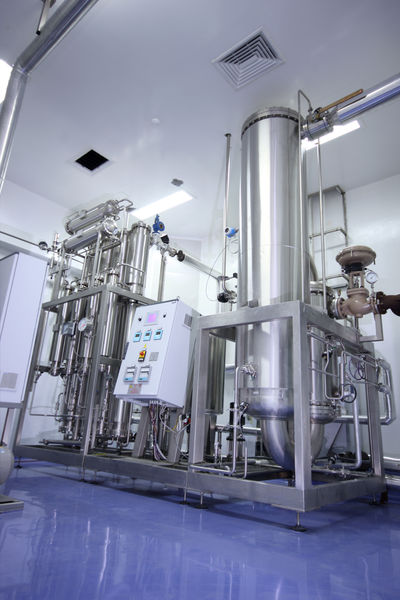Distillation and Filtration - How it works

Mixtures: Homogeneous and Heterogeneous
In contrast to a pure substance, a class that includes only elements and compounds, mixtures constitute a much broader category. Usually, a mixture consists of many compounds mixed together, but it is possible to have a mixture (air is an example) in which elemental substances are combined with compounds. Elements alone can be combined in a mixture, as when copper and zinc are alloyed to make brass. It is also possible to have a mixture of mixtures, as for example when milk (a particular type of mixture called an emulsion) is added to coffee.
It is sometimes difficult, without studying the chemical aspects involved, to recognize the difference between a mixture and a pure substance. A mixture, however, can be defined as a substance with a variable composition, meaning that if more of one component is added, it does not change the essential character of the mixture. People unconsciously recognize this when they joke, "Would you like a little coffee with your milk?"
This comment, made when someone puts a great quantity of milk into a cup of coffee, implies that we generally regard coffee and milk as a solution in which the coffee dissolves the milk. But even if someone made a cup of coffee that was half milk, so that the resulting substance had a vanilla-like color, we would still call it coffee. If the components of a pure substance are altered, however, it becomes something entirely different.
Two hydrogen atoms bonded to an oxygen atom create water, but when two hydrogen atoms bond to two oxygen atoms, this is hydrogen peroxide, an altogether different substance. Water at ordinary temperatures does not bubble, whereas hydrogen peroxide does. Hydrogen peroxide boils at a temperature more than 1.5 times the boiling point of water, and potatoes boiled in hydrogen peroxide would be nothing like potatoes boiled in water. Eating them, in fact, could very well be fatal.
HOMOGENEOUS VS. HETEROGENEOUS.
Unlike a compound or element, a mixture can never be broken down to a single type of molecule or atom, yet there are mixtures that appear to be the same throughout. These are called homogeneous mixtures, in which the properties and characteristics are the same throughout the mixture. In a heterogeneous mixture, on the other hand, the composition is not the same throughout, and in fact the mixture is separated into regions with varying properties.
Chemists of the past sometimes had difficulty distinguishing between homogeneous mixtures—virtually all of which can be described as solutions—and pure substances. Air, for example, appears to be a pure substance; yet there is no such thing as an "air molecule." Instead, air is composed primarily of nitrogen and oxygen, which appear in molecular rather than atomic form, along with separated atoms of noble gases and two important compounds: carbon dioxide and water. (Water exists in air as a vapor.)
There is less probability of confusing a heterogeneous mixture with a pure substance, because one of the defining aspects of a heterogeneous substance is the fact that it is clearly a mixture. When sand is added to a container of water, and the sand sinks to the bottom, it is obvious that there is no "sand-and-water" molecule pervading the entire mixture. Clearly, the upper portion of the container is mostly water, and the lower portion mostly sand.
Separating Mixtures
There are two basic processes for separating mixtures, distillation and filtration. In general, these are applied for the separation of homogeneous and heterogeneous mixtures, respectively. Distillation is the use of heat to separate the components of a liquid and/or gas, while filtration is the separation of solids from a fluid (either a gas or a liquid) by allowing the fluid to pass through a filter.
In a solution such as salt water, there are two components: the solvent (the water) and the solute (the salt). These can be separated by distillation in a laboratory using a burner placed under a beaker containing the salt water. As the water is heated, it passes out of the beaker in the form of steam, and travels through a tube cooled by a continual flow of cold water. Inside the tube, the steam condenses to form liquid water, which passes into a second beaker. Eventually, all of the solvent will be distilled from the first beaker, leaving behind the salt that constituted the solute of the original solution.
Distillation may seem like a chemical process, but in fact it is purely physical, because the composition of neither compound—salt or water—has been changed. As for filtration, it is clearly a physical process, just as heterogeneous mixtures are more obviously mixtures and not compounds. Suppose we wanted to separate the heterogeneous mixture we described earlier, of sand in water: all we would need would be a mesh screen through which the liquid could be strained, leaving behind the sand.
Despite the apparent simplicity of filtration, it can become rather complicated, as we shall see, in the treatment of sewage to turn it into water that poses no threat to the environment. Furthermore, it should be noted that sometimes these processes—distillation and filtration—are used in tandem. Suppose we had a mixture of sand and salt water taken from the beach, and we wanted to separate the mixture. The first step would involve the simpler process of filtration, separating the sand from the salt water. This would be followed by the separation of pure water and salt through the distillation process.
Comment about this article, ask questions, or add new information about this topic: